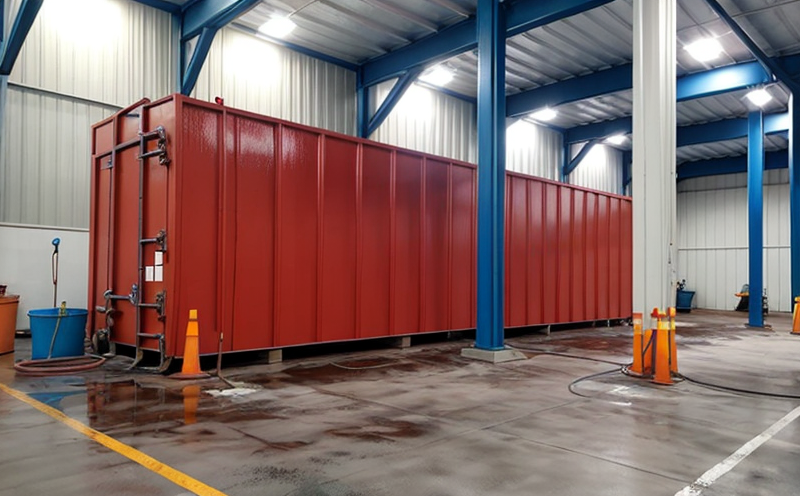ISO 2815 Buchholz Indentation Hardness Testing of Paints
The ISO 2815 Buchholz indentation hardness test is a critical method used to evaluate the resistance of industrial paints and coatings against mechanical stresses. This non-destructive testing technique provides a measure of how resistant a coating's surface is to indentation, which can be crucial for understanding its durability under real-world conditions. In industrial manufacturing, where products are exposed to harsh environments or rigorous handling processes, knowing the hardness properties of paint layers helps ensure that surfaces will withstand these stresses without degradation.
The test involves applying calibrated indentations on a prepared sample using an indentation tool designed specifically for this purpose. The depth and size of these indentations allow for accurate measurement of the material's resistance to deformation. This information is essential in quality assurance processes, where manufacturers aim to ensure that their products meet specific hardness requirements set by industry standards like ISO 2815.
Understanding the mechanical properties of industrial coatings such as paints and varnishes aids not only in meeting regulatory compliance but also in optimizing product performance. For instance, higher indentation hardness values indicate better resistance against impacts or scratches, which is particularly important for protective finishes on machinery components or structural elements that may experience abrasive conditions during operation.
Incorporating ISO 2815 Buchholz testing into the development and manufacturing phases allows companies to fine-tune their processes based on empirical data rather than relying solely on theoretical models. By conducting this test, manufacturers can identify potential weaknesses in their coating systems early enough to make necessary adjustments before mass production begins.
Additionally, it enables better decision-making regarding material selection for new projects or existing products undergoing modification. Understanding how different types of paints behave under various environmental stresses helps engineers specify the most appropriate materials for specific applications. This knowledge also contributes significantly towards enhancing overall product lifecycle management strategies by providing insights into expected service life expectations.
For R&D teams working on innovative formulations, this test offers valuable input when evaluating novel additives or pigment combinations that could improve paint performance. It serves as a baseline comparison against which future iterations can be measured. Furthermore, it allows them to assess the impact of changing factors such as drying conditions, application methods, or substrate types.
The Buchholz indentation hardness test is particularly useful for ensuring compliance with relevant international standards and specifications that govern industrial coatings. By adhering strictly to these guidelines during development stages, manufacturers can avoid costly rework and meet customer expectations more effectively. This aligns closely with modern quality management practices aimed at improving efficiency and reducing waste across all phases of production.
Overall, incorporating ISO 2815 Buchholz indentation hardness testing into an organization's quality control framework provides substantial benefits in terms of enhanced product reliability, increased confidence among stakeholders, and improved competitiveness within competitive markets.
Why It Matters
- Ensures compliance with international standards for industrial coatings
- Provides insights into the durability and performance of paint layers
- Helps optimize material selection based on empirical data
- Serves as a tool for identifying potential weaknesses in coating systems early
- Supports better decision-making regarding product lifecycle management
- Aids in evaluating the impact of changing factors like drying conditions and application methods
The Buchholz indentation hardness test plays an indispensable role in ensuring that industrial paints meet stringent quality requirements. By providing accurate measurements of a coating's resistance to indentation, this method enables manufacturers to make informed decisions about their products' design and manufacturing processes.
Why Choose This Test
- Accurate measurement of indentation hardness ensures precise evaluation of paint performance
- Non-destructive nature allows for repeated testing without damaging the sample
- Compliance with ISO 2815 standard guarantees reliability across different environments
- Provides valuable data for product development and optimization efforts
- Supports quality control initiatives by identifying potential issues early in the production cycle
- Aids in meeting regulatory requirements set forth by international standards bodies
Selecting ISO 2815 Buchholz indentation hardness testing as part of your industrial manufacturing and processing strategy ensures that you are using a validated, reliable method to assess the mechanical properties of paints. This approach not only enhances product reliability but also contributes significantly towards maintaining high levels of customer satisfaction.
Quality and Reliability Assurance
- The test helps in identifying any inconsistencies or variations in paint quality across batches or production runs
- By consistently meeting the specified hardness requirements, you can ensure consistent performance of your products under various conditions
- This testing method allows for continuous improvement by providing feedback on how different factors affect paint durability
- It plays a crucial role in maintaining strict adherence to international standards and specifications governing industrial coatings
- The results from this test can be used as part of a broader quality assurance program that includes other inspection methods such as visual checks or thickness measurements
Incorporating ISO 2815 Buchholz indentation hardness testing into your quality control protocols offers significant advantages in terms of maintaining consistent product performance and reliability. By leveraging this information, you can ensure that each batch of paint meets the necessary specifications while also identifying areas for improvement.





